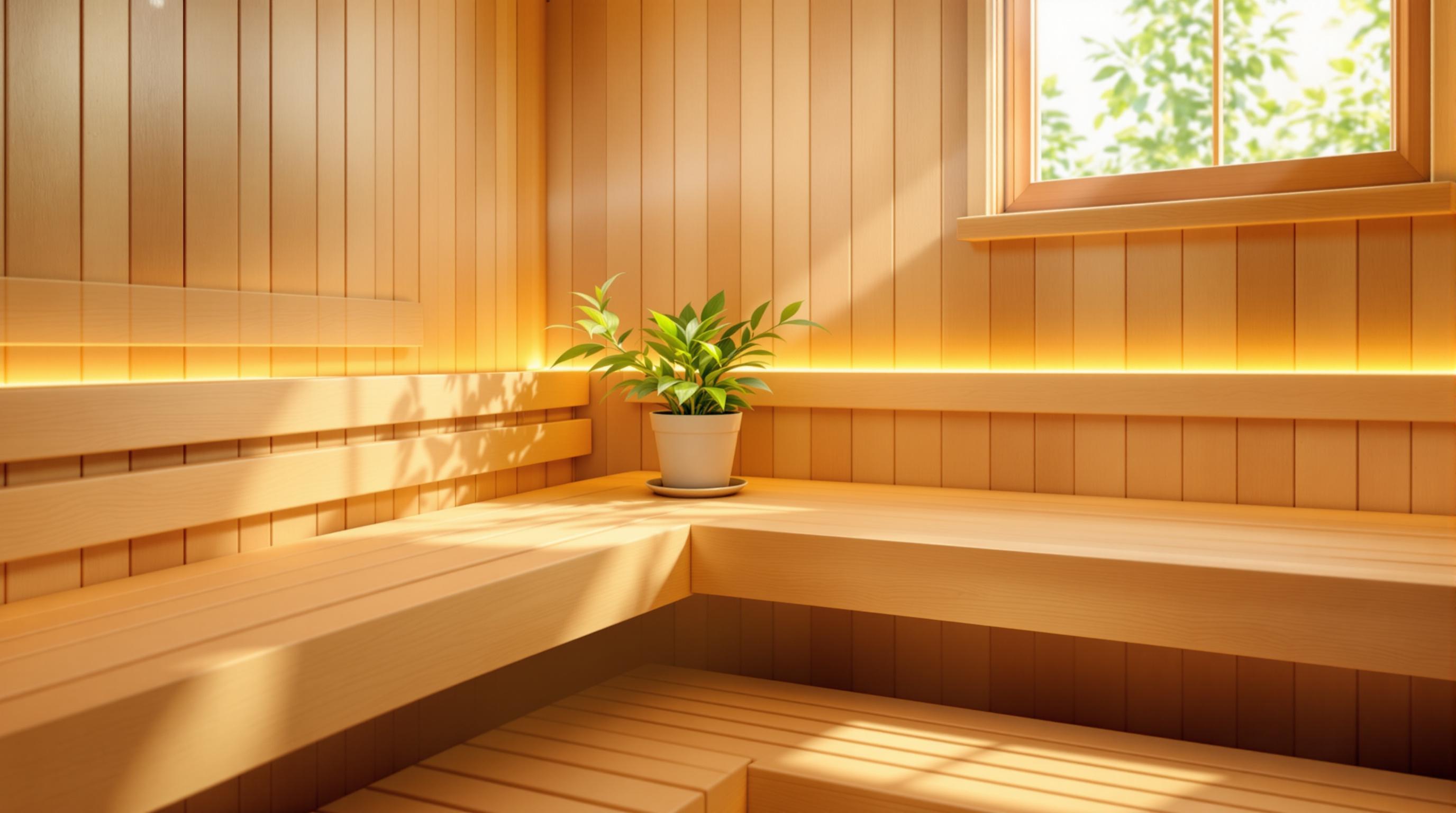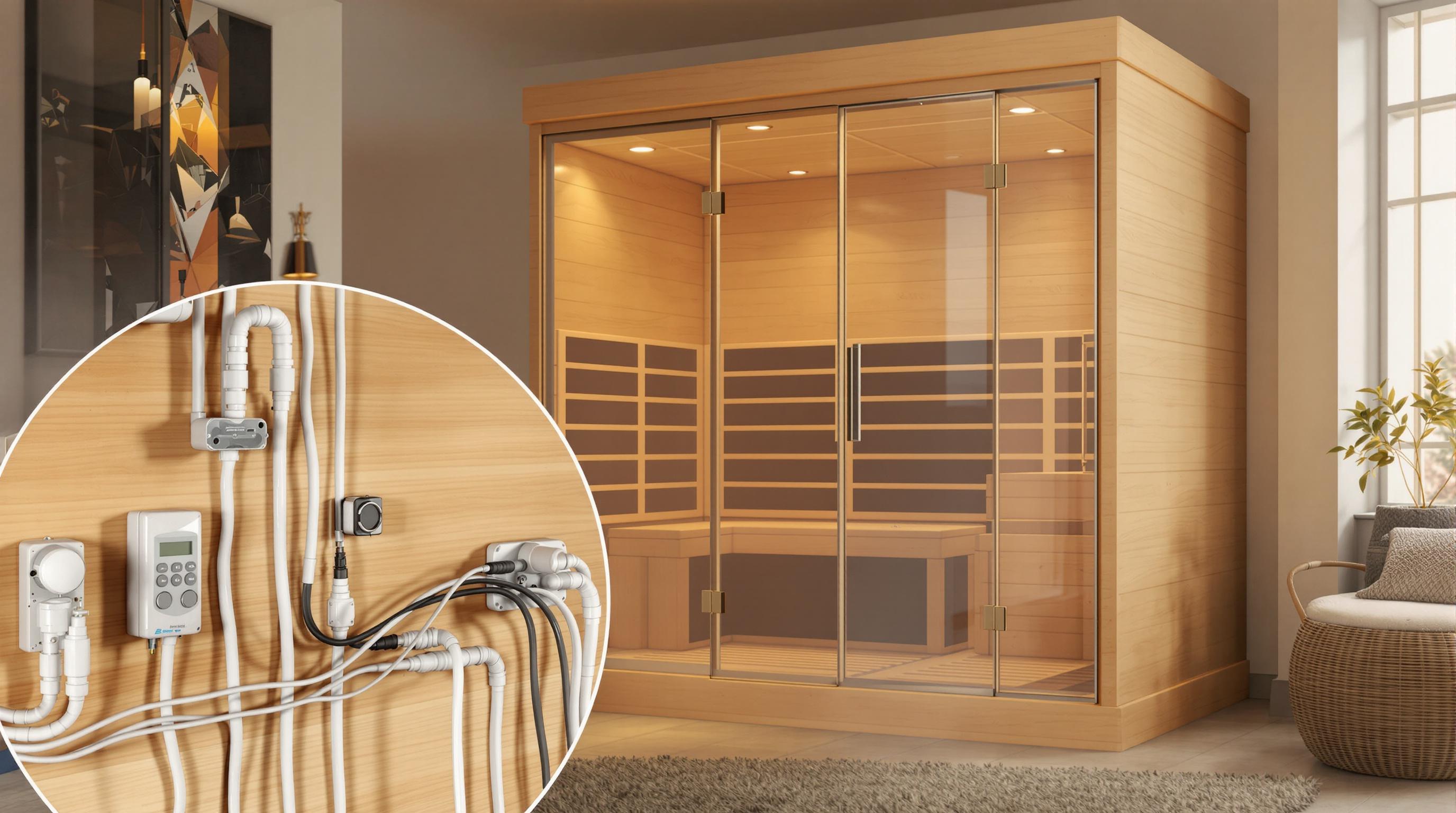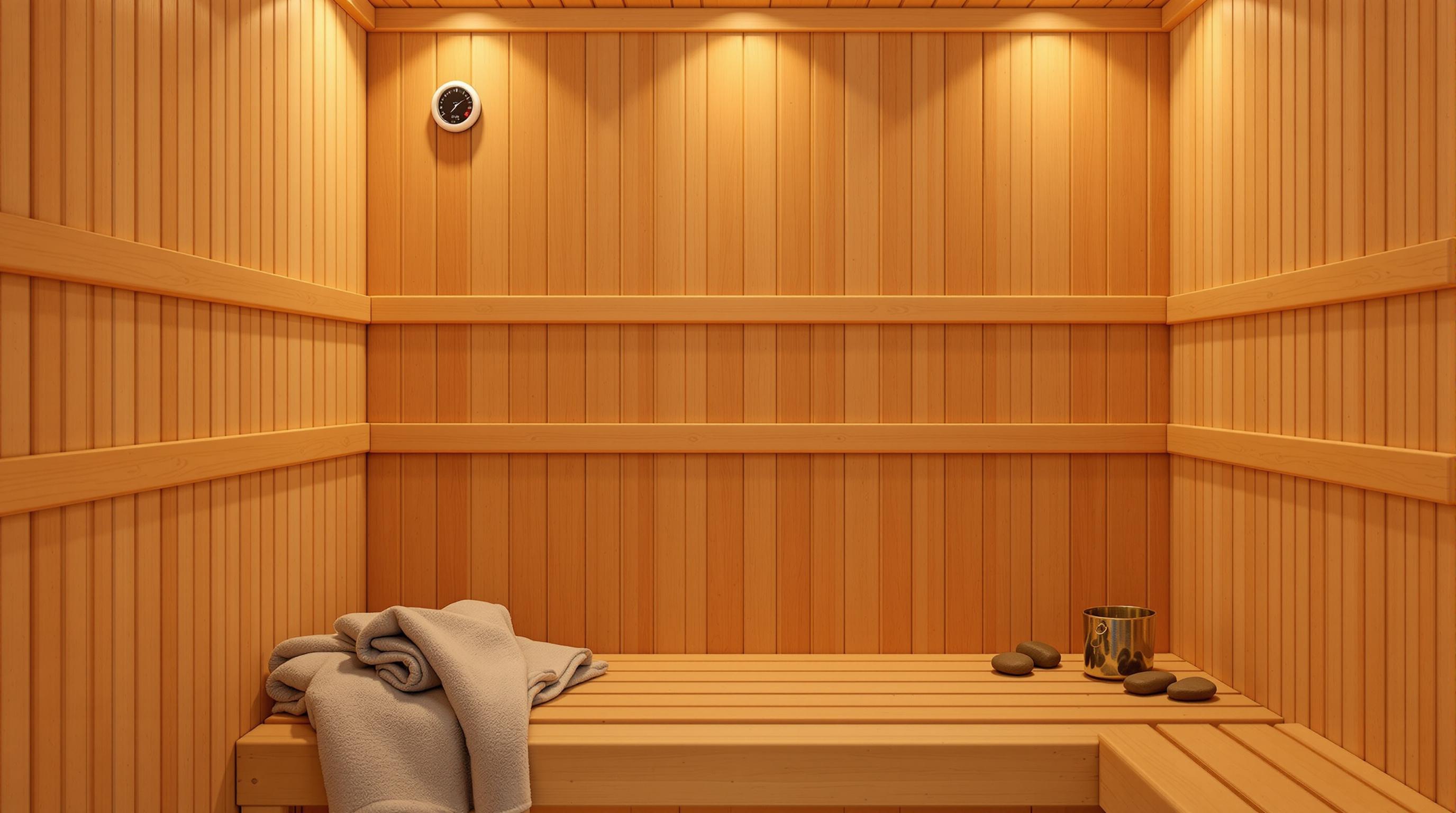Choosing the right sauna sealant is essential for protecting your wood and enhancing durability. Sauna owners typically choose between two types: water-based and oil-based sealants. Here's a quick breakdown of their differences:
- Water-Based Sealants: Eco-friendly with low VOCs, quick drying (1-2 hours), and easy clean-up. Ideal for interior saunas but requires reapplication every 1-2 years.
- Oil-Based Sealants: Long-lasting with deep wood penetration and high durability. Suited for exterior saunas but emits strong fumes and takes longer to dry (24-48 hours).
Quick Comparison
| Feature | Water-Based Sealants | Oil-Based Sealants |
|---|---|---|
| Drying Time | 1-2 hours (touch-dry) | 6-8 hours (touch-dry) |
| VOC Content | Less than 50 g/L | 350-400 g/L |
| Heat Resistance | Up to 180°F (82°C) | Up to 200°F (93°C) |
| Clean-up | Soap and water | Mineral spirits |
| Durability | Reapply every 1-2 years | Reapply every 3-5 years |
Choose water-based for indoor saunas or oil-based for outdoor setups. Tailor your choice to your sauna's location, climate, and maintenance needs.
Difference between Solvent and Water Based Sealers
Water-Based Sauna Sealants
Water-based sauna sealants are created using water-soluble resins mixed with additives designed to perform well in high-temperature settings. These sealants form a barrier that protects wood from moisture, heat, and UV exposure, all while preserving the wood's natural look. They're a great choice for those who prioritize eco-friendly solutions and quick application.
Benefits of Water-Based Sealants
These sealants are known for their low VOC emissions (under 50g/L), making them safer for indoor air quality. They dry quickly - usually within 1-2 hours - and can be cleaned up easily with soap and water. Their non-toxic formula helps maintain the wood's natural scent and allows it to breathe.
Drawbacks of Water-Based Sealants
Water-based sealants do need to be reapplied more often than oil-based ones - typically every 1-2 years compared to the 3-5 years for oil-based options. However, proper sealing can still significantly cut down overall maintenance by up to 73%.
Application requires specific conditions for the best results. The temperature should be between 50-90°F (10-32°C) during application, and the process may cause the wood grain to raise slightly, meaning you'll need to do some light sanding between coats. Additionally, these sealants don't penetrate the wood as deeply as oil-based alternatives, which can impact long-term protection.
Ideal Uses for Water-Based Sealants
Water-based sealants are best suited for:
- Interior surfaces like benches and walls
- Woods such as cedar, pine, or hemlock
- Both prefab and custom-built saunas
For best results, apply 2-3 thin coats and allow 24-48 hours for curing before using the sauna.
Oil-Based Sauna Sealants
Oil-based sealants are a go-to choice when durability and deep wood protection are priorities. Made with a mix of natural or synthetic oils, resins, and solvents, these sealants penetrate much deeper into the wood compared to water-based options, offering a long-lasting protective layer.
Advantages of Oil-Based Sealants
Oil-based sealants provide strong moisture resistance and excellent durability. Their deep-penetrating formula forms a flexible barrier that moves with the wood, helping to prevent cracking or peeling. On top of that, these sealants enhance the wood's natural appearance, highlighting its grain patterns and rich tones.
"Oil-based sealants offer superior protection for exterior sauna applications, especially in humid climates or areas with frequent temperature fluctuations." - John Smith, Master Sauna Builder, Sauna Experts Magazine
Challenges of Oil-Based Sealants
While effective, oil-based sealants have some downsides. They take longer to dry - typically 24-48 hours between coats - making the process more time-consuming. Additionally, they emit strong fumes during application, with VOC levels between 350-450 grams per liter, far higher than the under-50 grams per liter of water-based sealants.
To apply them, you'll need:
- Natural bristle brushes or lint-free cloths
- Mineral spirits for cleaning up
Best Applications for Oil-Based Sealants
These sealants shine in exterior surfaces and high-humidity areas, where deep wood penetration and robust protection are essential. They're especially suited for premium sauna installations, handling the intense 200°F/93°C conditions with ease. For demanding environments, oil-based sealants are tough to beat.
Comparison Table: Water-Based vs. Oil-Based Sealants
Here’s a breakdown of how water-based and oil-based sealants differ in key areas:
| Feature | Water-Based Sealants | Oil-Based Sealants |
|---|---|---|
| Drying Time | 1-2 hours (touch-dry) | 6-8 hours (touch-dry) |
| VOC Content | Less than 50 g/L | 350-400 g/L |
| Heat Resistance | Handles up to 180°F (82°C) | Withstands up to 200°F (93°C) |
| Clean-up | Easy with soap and water | Requires mineral spirits |
This comparison highlights the main differences between the two types of sealants, particularly in drying time, environmental factors, heat tolerance, and cleaning methods. These distinctions are crucial for choosing the right option for sauna applications.
sbb-itb-3953eb0
Choosing the Right Sauna Sealant
When picking a sealant for your sauna, there are a few key factors to consider to ensure the best performance and protection.
Interior vs. Exterior Use
Where your sauna is located plays a big role in the type of sealant you need.
- Interior Saunas: Water-based sealants are ideal here. They emit fewer VOCs, dry faster, and are safer for enclosed spaces. Plus, they offer solid protection against humidity and temperature changes.
- Exterior Saunas: For outdoor saunas, oil-based sealants are the better choice. Their stronger formulation holds up well against harsh weather and outdoor conditions.
Climate and Humidity Effects
The local climate can greatly impact how well a sealant performs. Here’s a quick breakdown of what works best in different conditions:
| Climate | Recommended Type | Why It Works |
|---|---|---|
| Humid Coastal | Marine-grade oil-based | Resists mold and mildew |
| Dry Desert | Moisture-retaining water-based | Keeps wood from drying out |
| Variable Temperature | Flexible hybrid formulas | Adapts to wood expansion/shrinkage |
| High UV Exposure | UV-inhibitor enhanced | Protects against sun damage |
Matching your sealant to your local weather ensures your sauna stays in top shape.
Aesthetics and Maintenance
Looks and upkeep also play a role in choosing the right sealant.
Water-based sealants are often chosen for their clean, polished finish - 65% of sauna owners initially prefer them for their appearance. However, many later switch to oil-based options because they’re easier to maintain.
If your sauna sees heavy use, durability becomes even more important. Opt for a long-lasting sealant that can handle wear and tear without frequent reapplication.
Find the Home Sauna of Your Dreams
Choosing the right sealant for your sauna depends on the type of wood and how often the sauna is used. Find the Home Sauna of Your Dreams (tophomesauna.com) provides detailed advice to help you make the best decision for maintaining your sauna.
The site covers essential wood care topics, including:
- Characteristics of different wood types
- How grain patterns affect sealing
- Compatibility with various construction materials
- Specific sealing techniques
They also offer expert consultations to provide personalized advice based on your sauna's setup. Plus, their FAQ section answers common questions about sealing, helping you ensure everything works smoothly with your sauna during upkeep.
Conclusion
Choosing the right sealant means considering factors like where it will be used, how often, and the local conditions. For indoor spaces, water-based sealants are a popular pick due to their low VOC levels and ease of use. On the other hand, oil-based sealants are better suited for tough outdoor environments because they offer deeper penetration.
Consumer demand for environmentally friendly products has pushed manufacturers to improve water-based options, making them more durable while still being eco-friendly [1][2]. When deciding between the two, focus on these key factors:
- Environmental conditions
- Frequency of use
- Maintenance requirements
- Local VOC regulations
As highlighted in the comparison table and application tips, success comes down to applying the sealant correctly, keeping up with maintenance, and tailoring the choice to your sauna's specific needs and environment.
FAQs
What is the best finish for a wood sauna?
Choosing the right finish for a wood sauna depends on its location and specific needs:
For interior saunas, water-based sealants are a solid choice. They dry quickly, have low VOC levels, and offer good protection. Natural oils like boiled linseed oil or tung oil are also great options. They soak deeply into the wood and are non-toxic, making them safe for indoor use.
"For those who prefer a finish, a high-quality, food-grade mineral oil or beeswax can provide protection without compromising the sauna experience."
For exterior saunas, oil-based sealants are better suited. They provide strong weather resistance and can handle UV exposure and moisture effectively. Always consider the environmental conditions when making your choice.
Here’s a quick overview of key factors to keep in mind:
| Factor | Primary Concerns |
|---|---|
| Interior Sauna | Heat resistance, low VOCs |
| Exterior Sauna | UV protection, moisture resistance |
When applying any finish, use thin coats and allow enough drying time between applications. Always opt for products specifically designed for sauna environments to ensure durability and safety.


